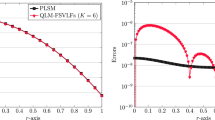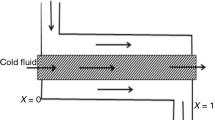Abstract
This paper studies the dynamics of nonlinear singular heat conduction model of the human head, and presents a new fractional heat conduction model for the human head taking into account the effect of febrifuge. The Taylor series and two-scale transform method are developed for solving the fractional model. The correctness and effectiveness of the proposed method are also ascertained through one example. The results show that the proposed method is simple but effective.


Similar content being viewed by others
References
U. Flesch, The distribution of heat sources in the human head: a theoretical consideration. J. Theor. Biol. 54(2), 285–287 (1975)
B.F. Gray, The distribution of heat sources in the human head—theoretical considerations. J. Theor. Biol. 82(3), 473–476 (1980)
G. Srinivasan, H. Gopalakrishnan, A new computational algorithm to nonlinear model of heat conduction in the human head. Int. J. ChemTech Res. 9(5), 529–535 (2016)
O.D. Makinde, Non-perturbative solutions of a nonlinear heat conduction model of the human head. Sci. Res. Essays 5(6), 529–532 (2010)
N. Anderson, A.M. Arthurs, Complementary extremum principles for a nonlinear model of heat conduction in the human head. Bull. Math. Biol. 43(3), 341–346 (1981)
R.M.A. Zahoor, U. Muhammad, S. Zulqurnain et al., A new stochastic computing paradigm for the dynamics of nonlinear singular heat conduction model of the human head. Eur. Phys. J. Plus 133(9), 364 (2018)
D. Kumar, J. Singh, K. Tanwar et al., A new fractional exothermic reactions model having constant heat source in porous media with power, exponential and Mittag-Leffler laws. Int. J. Heat Mass Transf. 138, 1222–1227 (2019)
D. Kumar, J. Singh, New aspects of fractional epidemiological model for computer viruses with Mittag–Leffler law, in Mathematical Modelling in Health, Social and Applied Sciences (Springer, Singapore, 2020), pp. 283–301
A. Goswami, J. Singh, D. Kumar et al., An efficient analytical approach for fractional equal width equations describing hydro-magnetic waves in cold plasma. Phys. A 524, 563–575 (2019)
D. Kumar, J. Singh, M. Al Qurashi, D. Baleanu, A new fractional SIRS-SI malaria disease model with application of vaccines, antimalarial drugs, and spraying. Adv. Differ. Equ. (2019). https://doi.org/10.1186/s13662-019-2199-9
K.J. Wang et al., The transient analysis for zero-input response of fractal RC circuit based on local fractional derivative. Alex. Eng. J. (2020). https://doi.org/10.1016/j.aej.2020.08.024
X.J. Yang, H.M. Srivastava, An asymptotic perturbation solution for a linear oscillator of free damped vibrations in fractal medium described by local fractional derivatives. Commun. Nonlinear Sci. Numer. Simul. 29(1–3), 499–504 (2015)
D. Baleanu, H. Mohammadi, S. Rezapour, Analysis of the model of HIV-1 infection of CD4 + T-cell with a new approach of fractional derivative. Adv. Differ. Equ. 2020(1), 1–17 (2020)
K. Wang, On a High-pass filter described by local fractional derivative. Fractals 28(03), 2050031 (2020)
K.J. Wang, H.C. Sun, Q.C. Cui, The fractional Sallen–Key filter described by local fractional derivative. IEEE Access (2020). https://doi.org/10.1109/access.2020.3022798
K.J. Wang et al., A ℘-order R-L high-pass filter modeled by local fractional derivative. Alex. Eng. J. 59(5), 3244–3248 (2020)
D. Baleanu, M. Jleli, S. Kumar et al., A fractional derivative with two singular kernels and application to a heat conduction problem. Adv. Differ. Equ. 2020, 252 (2020)
N.A. Triet, D. O’Regan, D. Baleanu et al., A filter method for inverse nonlinear sideways heat equation. Adv. Differ. Equ. 2020, 149 (2020)
H.M. Srivastava, F.A. Shah, R. Abass, An application of the Gegenbauer wavelet method for the numerical solution of the fractional Bagley–Torvik equation. Russ. J. Math. Phys. 26(1), 77–93 (2019)
K.L. Wang, K.J. Wang, A modification of the reduced differential transform method for fractional calculus. Therm. Sci. 22(4), 1871–1875 (2018)
J.H. He, A fractal variational theory for one-dimensional compressible flow in a microgravity space. Fractals 28(02), 2050024 (2020)
K.L. Wang, K.J. Wang, C.H. He, Physical insight of local fractional calculus and its application to fractional Kdv-Burgers equation. Fractal 27(7), 1950122-777 (2019)
J.H. He, A tutorial review on fractal spacetime and fractional calculus. Int. J. Theor. Phys. 53(11), 3698–3718 (2014)
J.H. He, Fractal calculus and its geometrical explanation. Results Phys. 10, 272–276 (2018)
Q.T. Ain, J.H. He, On two-scale dimension and its applications. Therm. Sci. 23(3B), 1707–1712 (2019)
J.H. He, F.Y. Ji, Two-scale mathematics and fractional calculus for thermodynamics. Therm. Sci. 23(4), 2131–2133 (2019)
Acknowledgements
This work is supported by Program of Henan Polytechnic University (No. B2018-40).
Author information
Authors and Affiliations
Corresponding author
Rights and permissions
About this article
Cite this article
Wang, KJ. A new fractional nonlinear singular heat conduction model for the human head considering the effect of febrifuge. Eur. Phys. J. Plus 135, 871 (2020). https://doi.org/10.1140/epjp/s13360-020-00891-x
Received:
Accepted:
Published:
DOI: https://doi.org/10.1140/epjp/s13360-020-00891-x




